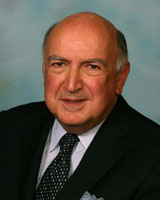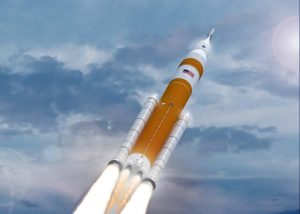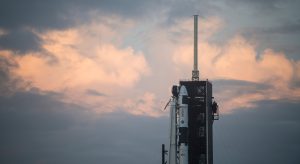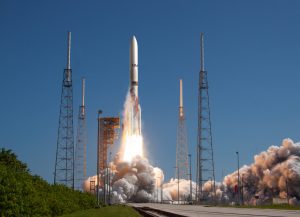DiBello On Space
July 8, 2021 – This guest column by Frank DiBello, president of Space Florida, appeared in Florida Today. DiBello has been instrumental in revitalizing the space industry, especially in Brevard County and this clear-eyed assessment should be essential reading to anyone interested in the state of space business.

Ten years ago this week, America watched the final space shuttle launch with a strong sense of pride.
No community felt this more personally than the Space Coast, where that pride was mixed with dread. Difficult days followed for our community as we lost thousands of high-wage jobs with the end of a massive federal space program.
In those uncertain times, the private space industry was just getting its legs. The future was hopeful, but success was far from certain.

The SLS is an advanced, heavy-lift rocket that will provide an entirely new capability for science and human exploration beyond Earth’s orbit. Credit: NASA
Today, we built upon the legacy of our national space programs to attract new commercial activity that has returned the Cape to the dominant spaceport on the planet. With the commercial space marketplace expanding not only its launch footprint, but also assembly, manufacturing, and processing of rockets and spacecraft, the spaceport has blossomed with added capability and expanded capacity. Such a dramatic transformation took hard work and is a source of pride for our community, our state, and our nation.
The future before us is exciting and rich with promise. But how did we get here?
The years following 2011 featured creative collaboration between NASA, Space Florida, and the commercial space industry in transitioning abandoned shuttle facilities to new uses.
The transition was not easy, and former Kennedy Space Center Director Bob Cabana should be lauded for piloting the agency through then-uncharted waters and championing the transition of KSC into a multi-user spaceport.
Although both are public entities, NASA and Space Florida are charged with different missions. Our vision and capabilities overlap in the re-purposing of excess government facilities to attract commercial activity, with NASA making facilities and land available for lease, and Space Florida bringing state investment and financing capabilities to attract industry. The classic example of this collaboration between NASA and Space Florida was the former Orbiter Processing Facility 3 converted into a world-class spacecraft assembly facility, now home to Boeing’s Starliner crew capsule.

A SpaceX Falcon 9 rocket with the company’s Crew Dragon spacecraft onboard is seen on the launch pad at Launch Complex 39A at NASA’s Kennedy Space Center in Florida.
Photo Credit: (NASA/Joel Kowsky)
The period that followed is marked by the development of Exploration Park, where hundreds of acres of KSC were leased to Space Florida to develop and manage as an industrial park. Today, it is home to Blue Origin and Airbus OneWeb Satellites manufacturing facilities. What little acreage is left is in high demand. Meanwhile, Space Florida investments in key infrastructure for SpaceX, ULA, and others enable an ever-increasing launch cadence.

Vulcan Centaur, United Launch Alliance’s next-generation American rocket, lifts off in this artist’s rendering.
Next in this collaboration is the expansion of new developable land at the Launch & Landing Facility (LLF), formerly known as the Shuttle Landing Facility. Enabled by an agreement with NASA to tap Space Florida’s unique capacity to grow commercial opportunity, Space Florida now operates and manages development at the LLF.
With the recently announced utility corridor project leveraging Florida Department of Transportation funding, we are providing power, water, and other improvements to enable hundreds of additional acres for new development.
Elsewhere, Space Florida continues to prepare for new launch capability at Launch Complex 20, leveraging a new license with the Space Force for use by Firefly Aerospace, while creating new multi-user pads nearby for additional launch capacity. At Launch Complex 46, Space Florida’s operation is now attracting new commercial small launch operators, while we continue to work closely with the Navy to enable more national security missions from the site.
Taken all together, this is now what is known as the Cape Canaveral Spaceport (CCS). Long identified in Florida Statute 331.304(1), the CCS refers to both KSC and the Cape Canaveral Space Force Station (CCSFS). As Florida’s statewide Spaceport Development Authority, Space Florida uses its toolkit across Florida’s Spaceport System, including at the CCS. NASA and the Space Force operate and manage KSC and CCSFS, respectively, and Space Florida provides management and operation of key spaceport elements.

This illustration shows NASA’s new rocket, the Space Launch System (SLS), in its Block 1 crew vehicle configuration. Image Credit: NASA/MSFC
Spurred by strong collaboration between Space Florida, NASA, Space Force, the EDC and others across the region, the last 10 years have seen a dynamic transformation of the Cape into a vibrant commercial space transportation hub.
Over the next 10 years, we must leverage this successful model while remaining open to change to ensure we retain our leadership position in a competitive global space race.
This community and the nation are counting on us.
Source: Florida Today







